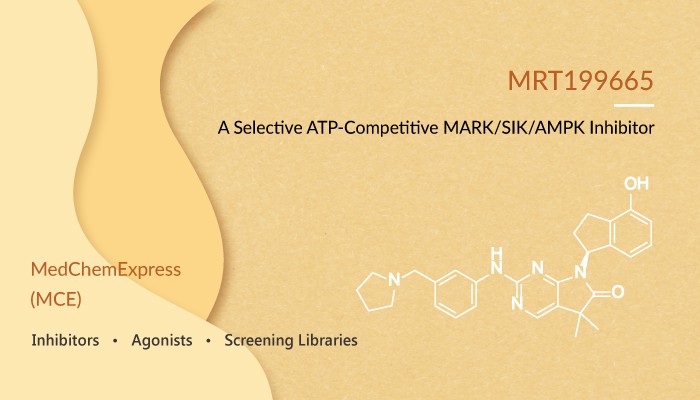In acute myeloid leukemia (AML), chemotherapy resistance remains prevalent and poorly understood. AML are cancers of the blood. They originate in the hematopoietic progenitor cells as a result of the accumulation of genetic mutations that lead to cell transformation. Prevalence of mutations of genes encoding regulators of gene expression characterizes in AML. MLL-AF9 gene fusion dysregulates the expression of genes controlling self-renewal, differentiation and cell survival. In addition, MEF2C S222 phosphorylation as a specific marker of primary chemoresistance. In this study, MRT199665 is a potent and ATP-competitive, selective MARK/SIK/AMPK inhibitor. It has IC50s of 2/2/3/2 nM, 10/10 nM, and 110/12/43 nM for MARK1/MARK2/MARK3/MARK14, AMPKα1/AMPKα2, and SIK1/SIK2/SIK3, respectively. MRT199665 is also a selective inhibitor to block MEF2C S222 phosphorylation. In addition, it causes apoptosis in MEF2C-activated human AML cells.

MRT199665 exhibits high selectivity and potency against MARK and the structurally similar SIK and MELK kinases as compared to other AMP kinase family members.
MRT199665 treatment can phenocopy the suppression of the MEF2C phosphorylation-induced gene expression program by the dominant-negative MEF2C S222A mutant. Furthermore, MRT199665 increases LPS -stimulated IL-10 mRNA and Nurr77 mRNA production, and IL-10 secretion. It leads to a dose-dependent reduction in total and pS222 MEF2C, causing more than 40% reduction in MEF2C phosphorylation at 10 nM. Moreover, MRT199665 treatment can block MEF2C S222 phosphorylation in AML cells. Meanwhile, it leads to a dose-dependent reduction in total and pS222 MEF2C. In addition, MRT199665 also causes a decrease in total MEF2C protein. Importantly, human AML cell lines with endogenous MEF2C phosphorylation (OCI-AML2, MV4–11, MOLM-13 and Kasumi-1) are significantly sensitized to cytarabine in the presence of 100 nM MRT199665.
In summary, the selective MARK/SIK/AMPK inhibitor MRT199665 causes apoptosis and confers chemosensitivity in MEF2C-activated human AML cell lines.
Reference:
Brown FC, et al. Cancer Discov. 2018 Apr;8(4):478-497.